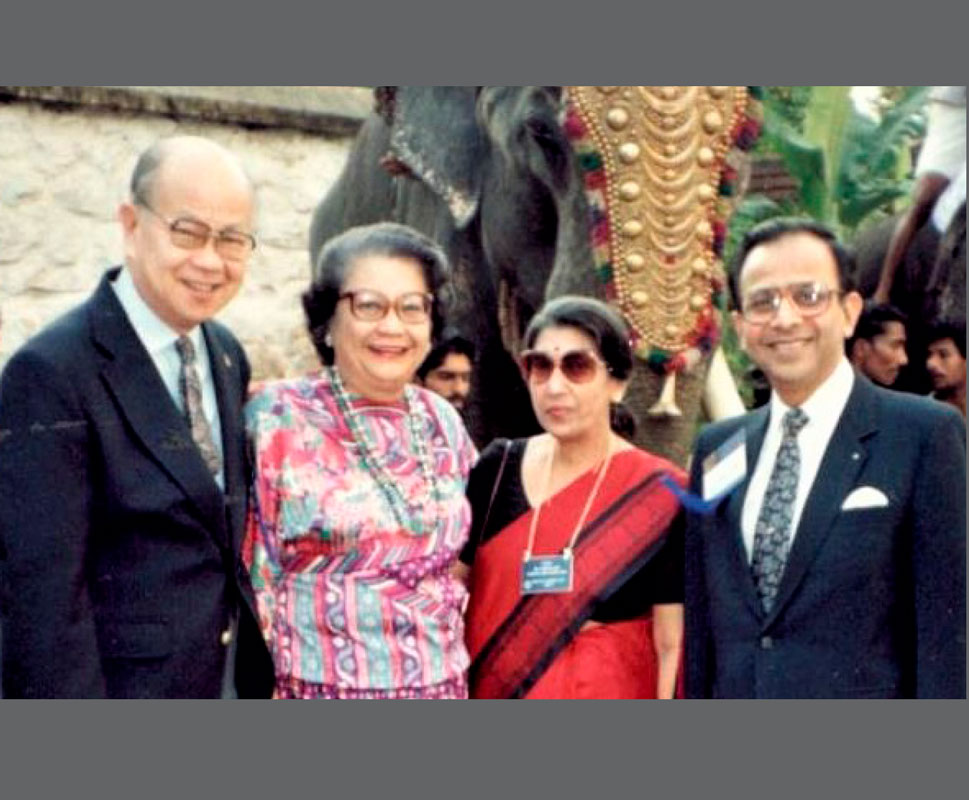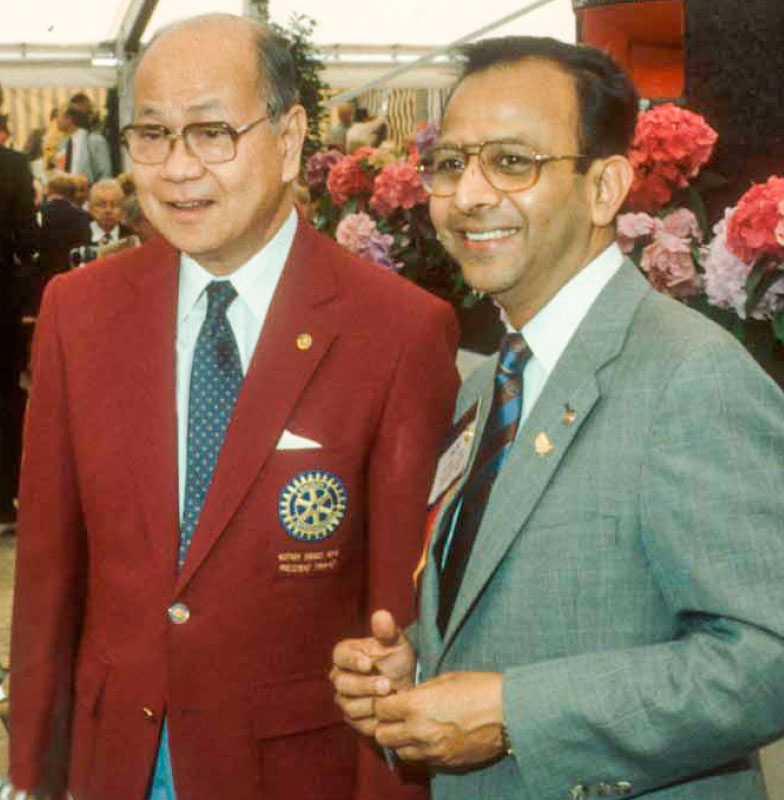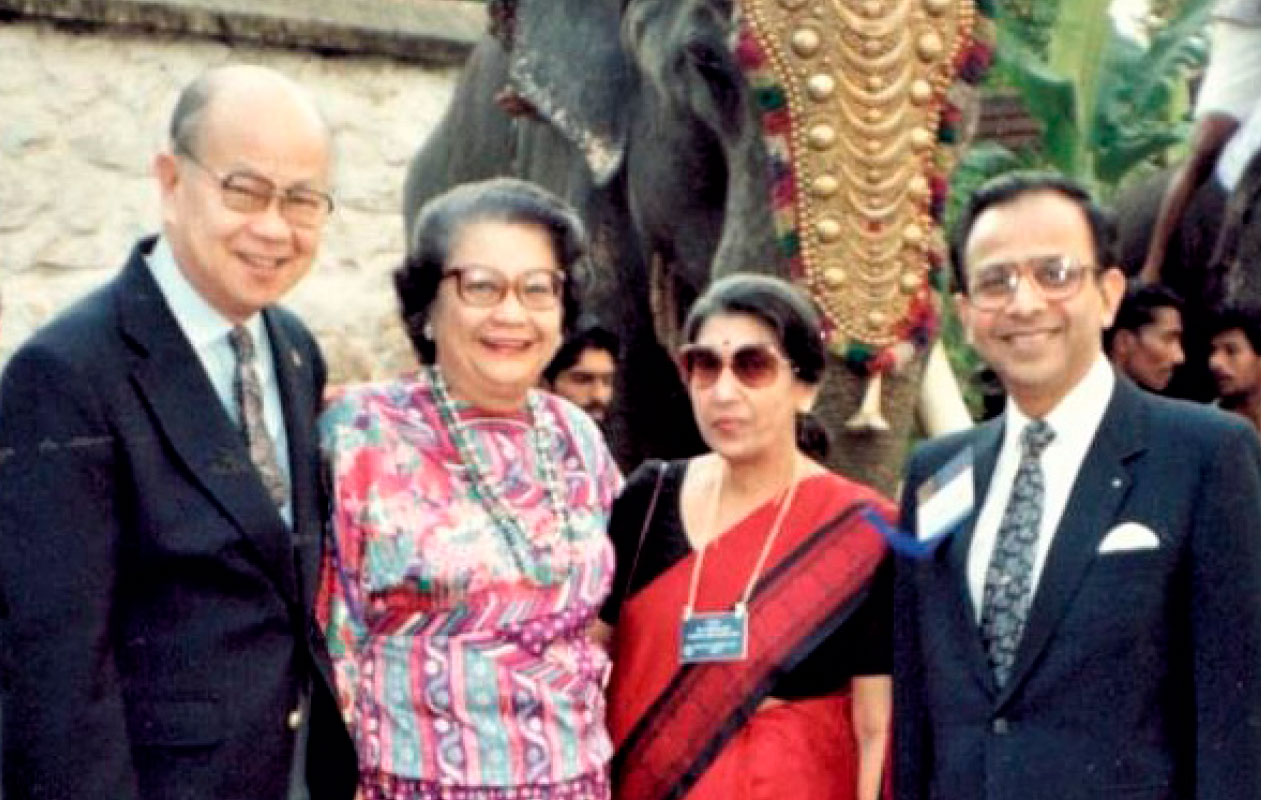If you have built castles in the air,
Your work need not be lost;
That is where they should be,
Now put foundation under them

– David Thoreau
The citadel has fallen. An era has gone by. The epitome of Rotary in Asia, particularly in South Asia, has passed away. And yet, it would be wrong to say that he was from South Asia. He was a gift to the entire world through Rotary. This visionary, who is no more with us, is Mateo Armando Tengco Caparas. His passing away at 96 must be considered a celebration of life. No one is immortal but he will be immortal for what he has done and the legacy he has left.
I met Mat, as he was fondly known, in April 1977 when as a district governor I attended my very first Rotary Institute in Manila, Philippines. I hardly knew then that he would become my mentor, guide and philosopher in my Rotary journey.

Mat became RI Director in 1979. RI President Jim Bomar Jr visited Philippines in September, 1979, and administered the first dose in what became Rotary’s global fight to eradicate polio. On that occasion, Mat had commented: “Great things always have a small beginning.” He and Dr Benny Santos were responsible in getting the polio doses offered by Rotary International to immunise 5.3 million Filipino children. In the second year of his term, Mat became RI Vice-President under President Rolf Klarich.
Following Mat, I became RI Director in 1981–83. The configuration then was such that South Asia, including India, comprised Zone 2; the rest of Asia, except Japan, formed Zone 4, which included two major Rotary countries, Korea and Philippines. A single seat for an RI Director alternated between Zones 2 and 4. Thus the seat on the RI Board vacated by Mat came to me. I recall that at the changeover ceremony at his last Board meet, Mat got up from his chair and ushered me to his, making very flattering remarks about me.
From that moment, not because of his remarks but his remarkable courtesy, I grew closer to him and took him as my mentor. He was much senior to me having been district governor in 1964–65; I was DG in 1976–77. He had higher educational qualifications and a much larger international exposure. Hence, I regularly sought his guidance on Board matters, difficulties and problems as also protocol. Mat’s wife Nita treated my wife Usha like her sister. Both Mat and Nita guided and smoothened our passage of two years when I was director.
In 1984, I was on the Nominating Committee to choose the RI President-nominee to serve as president in 1986–87. It was the turn of a non-American. One candidate was a very senior and capable Rotarian from South Africa, Gordon Valentine. Among other candidates was Mat Caparas. Very strong advocating for Gordon was done by my guru Hugh Archer. I opposed him on the ground that a president from South Africa, a country having apartheid, would split Rotary and proposed the name of the equally capable Mat Caparas. Ultimately, Mat was chosen as RI President.

Mat was very concerned that Rotary had not penetrated into rural and neighbourhood areas and was confined to urban and affluent places. Hence it was not fully using its potential to spread community services. He saw in his own rural areas women carrying water buckets up the hills to their homes. He felt that if through community service and with self-help supported by Rotary the villagers could construct a water well, these women would be spared this laborious task. Such thoughts prompted him to initiate the new programme — Rotary Village Corps (RVC) from July 1, 1986. He asked me to be the Chairman of the Committee to promote this programme, and we started promoting Rotary activities through RVC members, and Mat became known as its father. Subsequently, the name was changed to Rotary Community Corps. Speaking at the Munich RI Convention in 1987, I said that Rotary’s efforts to tap human resources in neighbourhoods and villages around the world for self-help and development were at the very heart of the RVC concept. It was received by the audience with applause, which pleased President Caparas.
Another example of Mat’s vision was seen when RI purchased the One Rotary Center on Sherman Avenue as the new premises of Rotary Headquarters, which shifted from 1560, Ridge Avenue, Evanston. It did bring financial strain on RI for 2–3 years and thereafter was considered as a sound investment. Now in hindsight, it has proved to be a blessing.
During 1986 when Mat was president, a significant development came up when the US Supreme Court decided that the women members of the Rotary Club of Duarte, California, were rightful members of Rotary. This judgment opened the door for women’s entry into Rotary in US, and a long debate on admission of women into our organisation was almost settled. This led to the Council on Legislation in 1989 in Singapore changing the RI Constitution, removing gender bias and allowing women’s admission in Rotary clubs all over the world.
Back to my journey with Mat, when time came for nomination of the RI President in 1989, he indicated that I should wait for two years. This was good enough for me. However, another very good Filipino friend, an angel in Rotary, Dr Benny Santos, insisted that it was my time and I had to put in my name. My reply was, “I would not do anything without Mat’s approval.” Benny was then visiting Calcutta and I too was there. Benny talked on an international call for almost 45 minutes and convinced Mat that Raja ought to go this year. Mat talked to me and gave his wholehearted approval. The rest is history.
My good fortune, as RI President, was to have Mat as the TRF Chair. I could not have asked for a better combination. Mat loved India, which he visited both as RI director and president, as well as later. He came to Chandigarh and inaugurated permanent homes for leprosy patients — a combined project of RCs Chandigarh and Chandigarh Midtown — who had stopped begging, tested negative, were gainfully employed and fully rehabilitated. These were the kind of projects that Mat and Nita loved and that’s why he came to India during his presidency. Mat was an ardent votary of polio eradication and as an outstanding speaker he promoted polio. No wonder Mat and Nita were aides to President Carlos Conseco and Maria Aurora. President Carlos was instrumental in taking the PolioPlus programme forward in the Rotary world. Mat too was totally committed and involved.
Mat was appointed in 1988 by the then Philippines President Corazon Aquino as Chairman of the Presidential Commission on Good Governance, as its fourth chair and was tasked to retrieve the Marcos administration’s ill-gotten wealth and return it to the national treasury.
Usha and I visited Nita and Mat at their Mountain View home in California many times. Their affection always attracted us. Nita’s health started failing and a time came when she could not entertain guests at home. Mat was a regular at International Assemblies and attended conventions once in a while. He would bring Nita’s photos and news about her, and connect such events to Nita through a technical video system. That was their mutual love and love for Rotary.
The couple suffered tragedies in life when their young son and young daughter passed away. And yet they believed in destiny and their faith carried them in their life journey. When Nita died, Mat accepted the resulting loneliness with fortitude. He continued to love Rotary and his family — two sons, Jorge and his wife Charissa, Mateo and his wife Chona, and one daughter, Pilar de Villa and her husband Jovy, and grand and great grandchildren.
He was an impassioned positive thinker. This probably was the genesis of the powerful theme he gave to the world, Rotary Brings Hope. He believed that, “Hope is a waking dream”. His dreams were to build castles in the air and he put a foundation to them.
The divinity in Mat propelled him in the journey beyond the mortal world and now he has reached the stars.
The writer is a past RI President
A Christmas letter
Edited excerpts from a letter written by
PRIP Mat Caparas to PRIP Saboo
A very confused season is upon us again to remember people, greet and gift friends, and assume a happy appearance that one may not necessarily feel. It is Christmas time, many use the day to brag about their children or grandchildren, or other good things that might have happened to them during the year. I have never had anything to brag about in the past, nor the ability to design and make pretty cards to say so, but with God’s grace I have continued to live and remain lucid, and that has been the usual content of my Christmas letters, including this one that I write in extremely different circumstance.
I write it alone without my wife, so I write this with many pauses, which I hope will not affect its trend. The seven past presidents who lost their wives and have remarried will understand.
Let me answer your charge that I tried to stop you from putting your name for president when you did. That is true, but not because you were not yet ready for the office. You could be a good president after your term with the board expired. (When it happened) all of India was jubilant on your election. India began to make great strides since then in Rotary, thanks to your leadership, and the great inspiration and support of our dear Usha.
I have just given you a demonstration of how I am spending my life these days. “Passing time” is the usual way of saying it. But time is life, and I can still spend it in service to others through Rotary. That is why I stick to Rotary despite my unhappiness with many things our leaders do. Most of my friends are Rotarians, and now that I can move very little, I am inspired by my friend who continues to serve beyond the grave. I will be so happy if everyone with whom I share this letter will join me in ways to serve beyond the grave. Then maybe they will generously support the major projects of the Foundation that friends are establishing in my name on December 28.





